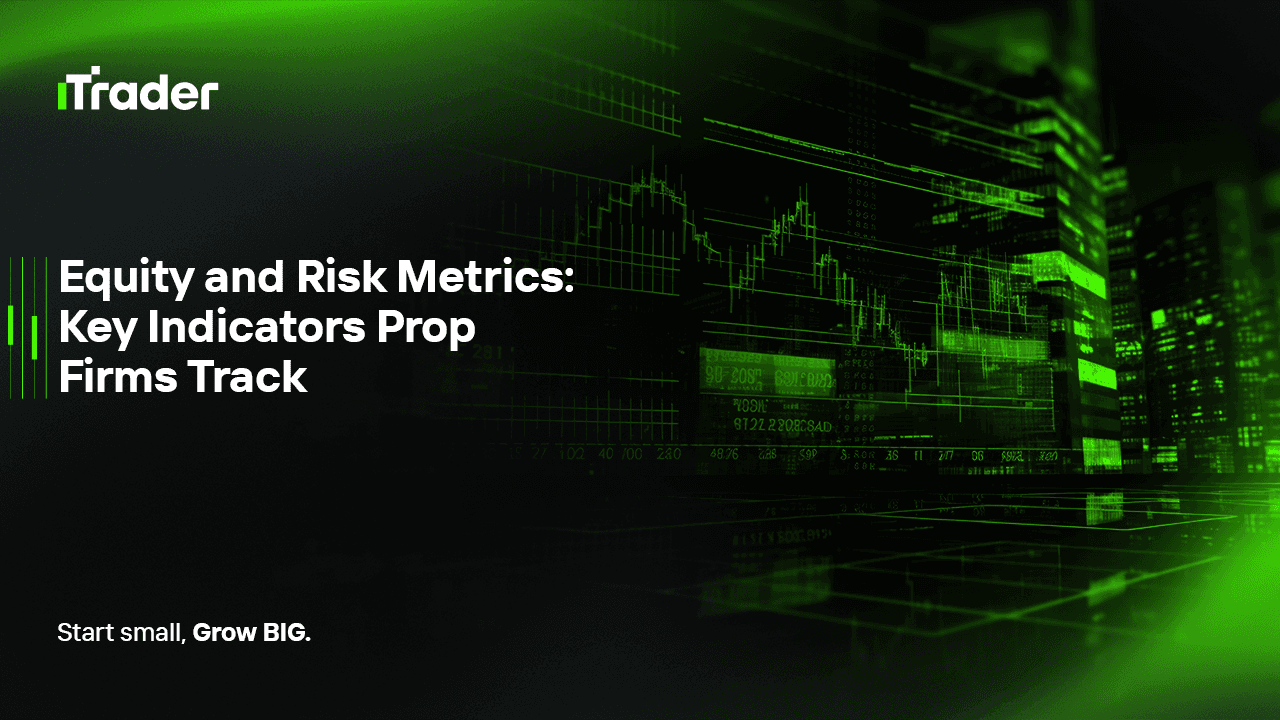2025-09-18
Every trader dreams of landing a funded account with a prop firm. The appeal is obvious: you get access to significant trading capital without risking your own money beyond the evaluation fee. But while most aspiring traders focus on how much profit they can make, prop firms are focused on something far more important: how you manage risk and equity over time.
Prop firms don’t just want traders who can hit a big profit target once. They want traders who can survive the long game. To them, it’s not about whether you can make 10% in a month — it’s about whether you can manage equity drawdowns, respect daily loss limits, and trade consistently without gambling. That’s why equity and risk metrics are at the very heart of every prop firm evaluation.

In this blog, we’ll explore the exact equity and risk metrics prop firms care about most. You’ll learn why these numbers matter, how they’re calculated, and how you can align your trading strategy with them to improve your chances of passing evaluations and keeping a funded account.
Let’s start with the basics.
Balance: This is the cash in your account excluding any open trades. If you closed all your trades right now, your balance is what you’d have.
Equity: This is your balance plus or minus any floating profit or loss from open positions.
Formula:
Equity = Balance + FloatingPnL
Example:
Equity = $10,000 + (300 – 100) = $10,200
Why prop firms care:
If your balance is $10,000 but your equity temporarily drops to $9,000 because of floating drawdown, a prop firm will count that $1,000 drop against your daily or maximum drawdown limits. In other words, equity is the true measure of risk, and it’s what firms monitor most closely.
Making money in the markets is only half the story. Without proper risk management, profits are temporary, and losses can wipe out accounts overnight. Prop firms know this, which is why their evaluations are designed to filter for traders who respect risk limits.
Risk metrics tell the firm:
These metrics don’t just matter for the evaluation stage — they’re also used once you’re funded. If you breach risk limits in a live account, your funding will be revoked, regardless of how profitable you were before.
Let’s go through the most common and important ones.
Example:
Starting balance: $100,000
Max DD limit: -$10,000
If your equity drops to $90,000 at any point, you fail the challenge.
Example:
Account: $100,000
Daily DD limit: -$5,000
If your equity drops below $95,000 on any given day — even for a second — the account is violated.
Prop firms know that one lucky trade doesn’t prove skill. That’s why they enforce rules around consistency:
Example rule: “No single trade can account for more than 30% of total profits.”
This ensures traders don’t bet big once and pray for a lucky outcome.
Example:
Passing a prop challenge isn’t just about hitting the profit target. It’s about respecting every single risk metric along the way.
Scenarios:
This is why traders who only focus on the profit target often fail challenges. Successful prop traders understand that risk metrics are the real test.
It’s worth noting that risk metrics aren’t just numbers — they’re psychological filters. Prop firms know:
By enforcing these rules, firms protect their capital and ensure only resilient, consistent traders move forward.
Equity and risk metrics form the backbone of prop firm evaluations. While many traders obsess over profit targets, the reality is that drawdowns, daily loss limits, consistency, and risk management matter far more. Prop firms aren’t searching for one-time winners — they’re searching for traders who can manage equity responsibly and perform sustainably in the long run.
If you want to succeed in prop trading, shift your mindset:
That’s the true path to not just passing evaluations, but keeping your funding and growing as a professional trader.
© 2025 iTrader Global Limited | หมายเลขทะเบียนบริษัท: 15962
iTrader Global Limited ตั้งอยู่ที่ Hamchako, Mutsamudu, เกาะปกครองตนเอง Anjouan, สหภาพคอโมโรส และได้รับใบอนุญาตและอยู่ภายใต้การกำกับดูแลของคณะกรรมการหลักทรัพย์แห่งคอโมโรส ภายใต้หมายเลขใบอนุญาต L15962/ITGL
iTrader Global Limited ดำเนินการภายใต้ชื่อทางการค้า “iTrader” และได้รับอนุญาตให้ดำเนินกิจกรรมการซื้อขายฟอเร็กซ์ โลโก้ เครื่องหมายการค้า และเว็บไซต์ของบริษัทเป็นทรัพย์สินเฉพาะของ iTrader Global Limited
บริษัทย่อยอื่น ๆ ของ iTrader Global Limited ได้แก่ iTrader Global Pty Ltd หมายเลขทะเบียนบริษัทออสเตรเลีย (ACN): 686 857 198 โดยบริษัทนี้เป็นตัวแทนที่ได้รับอนุญาต (หมายเลขตัวแทนบริการทางการเงินของออสเตรเลีย (AFS): 001315037) ของ Opheleo Holdings Pty Ltd (ใบอนุญาตบริการทางการเงินของออสเตรเลีย (AFSL): 000224485) ซึ่งมีที่อยู่จดทะเบียนอยู่ที่ Level 1, 256 Rundle St, Adelaide, SA 5000 ข้อจำกัดความรับผิดชอบ: นิติบุคคลนี้ไม่ใช่ผู้ออก และไม่รับผิดชอบต่อผลิตภัณฑ์ทางการเงินที่ซื้อขายบนหรือผ่านเว็บไซต์นี้
คำเตือนความเสี่ยง: การซื้อขาย CFD มีความเสี่ยงสูงต่อการสูญเสียเงินทุนอย่างรวดเร็วเนื่องจากเลเวอเรจ และอาจไม่เหมาะสมกับผู้ใช้ทุกคน
การซื้อขายกองทุน CFD และผลิตภัณฑ์ที่มีเลเวอเรจสูงอื่น ๆ ต้องการความรู้เฉพาะทาง
จากผลการวิจัยพบว่า 84.01% ของผู้เทรดที่ใช้เลเวอเรจประสบกับการขาดทุน
โปรดตรวจสอบให้แน่ใจว่าคุณเข้าใจความเสี่ยงทั้งหมด และพร้อมที่จะสูญเสียเงินทุนก่อนที่คุณจะเข้าร่วมการซื้อขายที่มีเลเวอเรจ
iTrader ขอประกาศว่า บริษัทจะไม่รับผิดชอบต่อความเสี่ยง ความเสียหาย หรือการสูญเสียใด ๆ ที่เกิดขึ้นจากการซื้อขายแบบมีเลเวอเรจต่อบุคคลหรือนิติบุคคลใด ๆ ทั้งสิ้น
ข่าวสารและข้อมูลที่ปรากฏบนเว็บไซต์นี้มีไว้เพื่อวัตถุประสงค์ทางการศึกษาเท่านั้น ผู้ใช้ควรตัดสินใจทางการเงินอย่างอิสระและโดยใช้ข้อมูลอย่างรอบคอบ
ข้อจำกัด: iTrader ไม่ได้มุ่งเป้าเว็บไซต์หรือบริการไปยังผู้อยู่อาศัยในประเทศที่กฎหมายหรือข้อบังคับห้ามไม่ให้มีการทำธุรกรรมดังกล่าว
หากคุณอาศัยอยู่ในเขตอำนาจที่การใช้เว็บไซต์หรือบริการนี้ถูกจำกัด คุณต้องรับผิดชอบในการปฏิบัติตามกฎหมายท้องถิ่น
iTrader ไม่รับประกันว่าเนื้อหาบนเว็บไซต์ของบริษัทจะเหมาะสมหรือถูกต้องตามกฎหมายในทุกพื้นที่